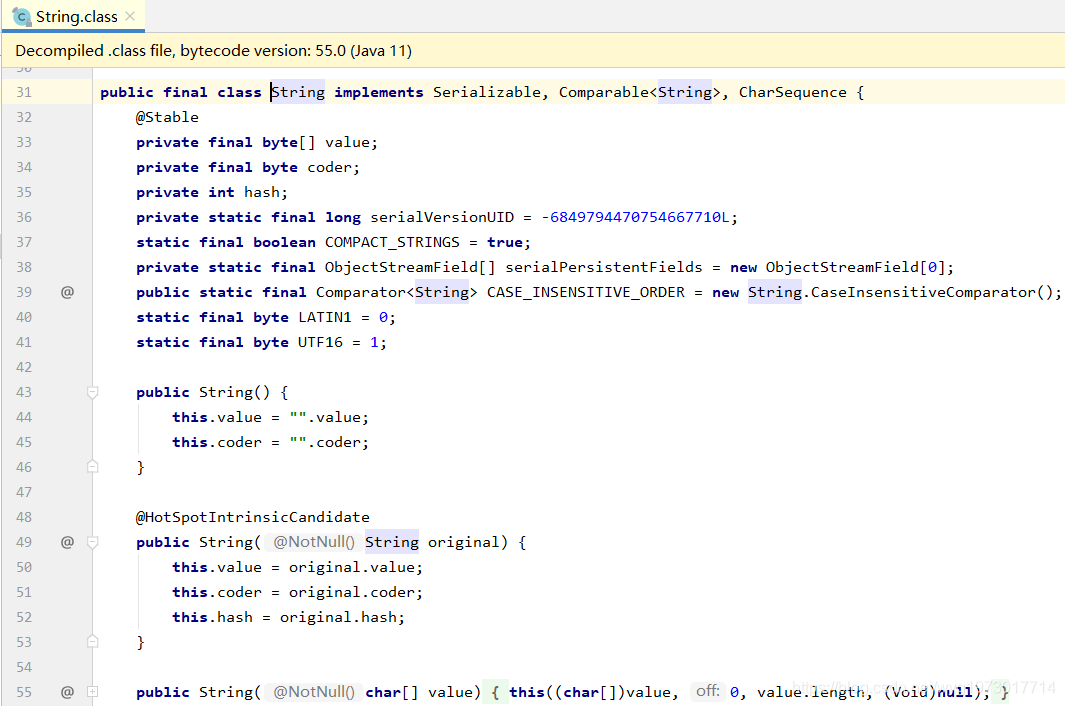Java String、StringBuffer、StringBuilder(基于源码探索)
本文共 2510 字,大约阅读时间需要 8 分钟。
String、StringBuffer、StringBuilder
1、String
String是Java类对象,Java通过String来创建和操作字符串。
从源码中我们可以看出,String使用byte[]数组进行字符串的存储,且byte[]数组被final关键字修饰。我们知道当final修饰成员变量时,如果成员变量是基本数据类型的变量那么该变量一旦初始化以后就不可更改,源码中value数组是在构造方法中赋初值,因此String类对象一旦被创建就不可更改。
故String类对象是不可变的。
 在实际应用过程中,我们可以通过 + 号来连接两个字符串,然后输出一个新的字符串
在实际应用过程中,我们可以通过 + 号来连接两个字符串,然后输出一个新的字符串 public static void main(String[] args) { String a = "wyg and "; String b = "wind"; System.out.print(a + b);} 以上代码运行输出以下结果
 虽然String类对象不可变,但是我们可以通过加号(+)来进行拼接两个字符串,或者通过String提供的函数concat(String str),下面是其源码,我们可以发现concat方法直接返回了一个新的String类对象。
虽然String类对象不可变,但是我们可以通过加号(+)来进行拼接两个字符串,或者通过String提供的函数concat(String str),下面是其源码,我们可以发现concat方法直接返回了一个新的String类对象。  还有一种情况请看以下代码:
还有一种情况请看以下代码: public static void main(String[] args) { String a = "wyg and "; a = a + "wind"; System.out.print(a);} 代码输出结果为wyg and wind
这样看似String对象a被改变了,但是实际上并非如此,而是在在运行过程中JVM又创建了一个a对象,并把原a对象和新增字符串的值赋值给了这个新对象,然后原a对象就被JVM的GC(垃圾回收机制)给回收掉了。
Java中对String对象进行的操作实际上是一个不断创建新的对象并且将旧的对象回收的一个过程,所以执行速度很慢。
String类还有很多有用的方法,可以在具体使用中通过源码进行研究
2、StringBuffer
StringBuffer类继承自AbstractStringBuilder类
 AbstractStringBuilder类的成员变量value也是byte类型数组,但是未被final关键字修饰,因此我们可以知道该成员变量是可变的
AbstractStringBuilder类的成员变量value也是byte类型数组,但是未被final关键字修饰,因此我们可以知道该成员变量是可变的 故StringBuffer是可变字符串


 除了append函数以外还有replace、insert等函数来改变StringBuffer对象的值。具体可以参考源码
除了append函数以外还有replace、insert等函数来改变StringBuffer对象的值。具体可以参考源码 3、StringBuilder

其他具体方法的实现不再赘述。
4、StringBuffer与StringBuilder区别
(1)缓冲区
以下是StringBuffer的toString()方法:@HotSpotIntrinsicCandidate public synchronized String toString() { return this.toStringCache == null ? (this.toStringCache = this.isLatin1() ? StringLatin1.newString(this.value, 0, this.count) : StringUTF16.newString(this.value, 0, this.count)) : new String(this.toStringCache); } 从中我们可以看出StringBuffer每次获取 toString 都会直接使用缓存区的 toStringCache 值来构造一个字符串
再来看看StringBuilder的toString()方法:@HotSpotIntrinsicCandidate public String toString() { return this.isLatin1() ? StringLatin1.newString(this.value, 0, this.count) : StringUTF16.newString(this.value, 0, this.count); } 可知StringBuilder 每次都需要复制一次字符数组,再构造一个字符串。
StringBuffer的缓冲区是对其自身的一种优化,同时,他也是同步的方法,线程安全。 (2)性能 StringBuffer 是线程安全的,它的所有公开方法都是同步的,StringBuilder 是没有对方法加锁同步的,所以毫无疑问,StringBuilder 的性能要远大于StringBuffer。5、实际运用如何选择?
- StringBuffer 适用于用在多线程操作同一个 StringBuffer 的场景,如果是单线程场合 StringBuilder 更适合。
- 实际运行速度:StringBuilder > StringBuffer > String,StringBuilder 效率最高
- 操作少量的数据可以选择String
- 在单线程中操作大量数据可以选择StringBuilder
- 在多线程中操作大量数据可以选择StringBuffer
- https://www.zhihu.com/question/20101840 可以看看知乎上这个问题
转载地址:http://cteo.baihongyu.com/
你可能感兴趣的文章
Nginx配置后台网关映射路径
查看>>
nginx配置域名和ip同时访问、开放多端口
查看>>
Nginx配置多个不同端口服务共用80端口
查看>>
Nginx配置好ssl,但$_SERVER[‘HTTPS‘]取不到值
查看>>
Nginx配置如何一键生成
查看>>
Nginx配置实例-动静分离实例:搭建静态资源服务器
查看>>
Nginx配置实例-反向代理实例:根据访问的路径跳转到不同端口的服务中
查看>>
Nginx配置实例-反向代理实现浏览器请求Nginx跳转到服务器某页面
查看>>
Nginx配置实例-负载均衡实例:平均访问多台服务器
查看>>
Nginx配置文件nginx.conf中文详解(总结)
查看>>
Nginx配置自带的stub状态实现活动监控指标
查看>>
nginx配置详解、端口重定向和504
查看>>
Nginx配置负载均衡到后台网关集群
查看>>
Nginx配置限流,技能拉满!
查看>>
Nginx配置静态代理/静态资源映射时root与alias的区别,带前缀映射用alias
查看>>
Nginx面试三连问:Nginx如何工作?负载均衡策略有哪些?如何限流?
查看>>
Nginx:NginxConfig可视化配置工具安装
查看>>
ngModelController
查看>>
ngrok | 内网穿透,支持 HTTPS、国内访问、静态域名
查看>>
ngrok内网穿透可以实现资源共享吗?快解析更加简洁
查看>>